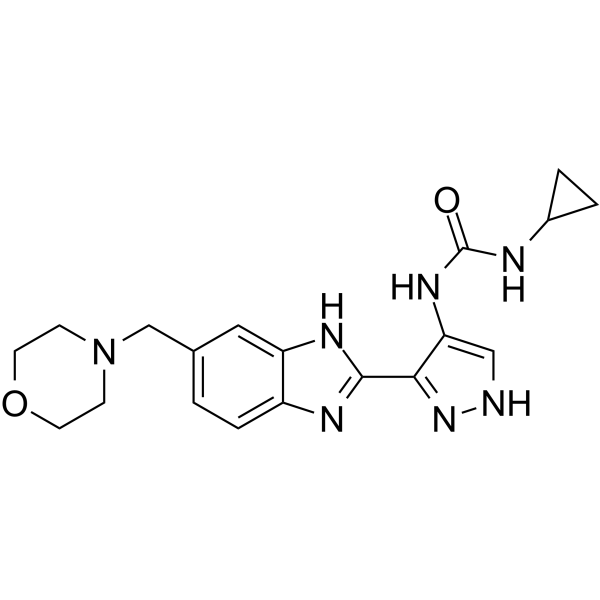Home
Products
AT9283



| Product Name | AT9283 |
| Price: | Inquiry |
| Catalog No.: | CN00175 |
| CAS No.: | 896466-04-9 |
| Molecular Formula: | C19H23N7O2 |
| Molecular Weight: | 381.43 g/mol |
| Purity: | >=98% |
| Type of Compound: | Alkaloids |
| Physical Desc.: | Powder |
| Source: | |
| Solvent: | Chloroform, Dichloromethane, Ethyl Acetate, DMSO, Acetone, etc. |
| SMILES: | O=C(Nc1c[nH]nc1c1nc2c([nH]1)ccc(c2)CN1CCOCC1)NC1CC1 |
| Contact us | |
|---|---|
| First Name: | |
| Last Name: | |
| E-mail: | |
| Question: | |
| Description | AT9283 is a multitargeted kinase inhibitor which potently inhibits aurora kinase A/B, JAK2/3 (IC50=1.2 nM, 1.1 nM). |
| Target | JAK2:1.2 nM (IC50) JAK3:1.1 nM (IC50) Aurora A:3 nM (IC50) Aurora B:3 nM (IC50) Abl (T315I):4 nM (IC50) |
| In Vitro | AT9283 leads to a clear polyploid phenotype by inhibiting the activity of Aurora B kinase in HCT116 cells with IC50 of 30 nM. Furthermore, AT9283 also produces the potent inhibition on HCT116 colony formation[1]. AT9283 induces apoptosis in a dose and time dependent manner and inhibits cell proliferation with an IC50 < 1 μM in B-NHL cell lines[2]. AT9283 inhibits growth, induces dose dependent cytotoxicity, and inhibits STAT3 signaling pathway in MM cell lines. T9283 inhibits phospho Histone H3 and phospho Aurora A at Thr 288. AT9283 increases G2/M phase and induces apoptosis of MM cells in a time-dependent manner[3]. |
| In Vivo | In HCT116 human colon carcinoma xenograft bearing mice, AT9283 treatment (15 mg/kg and 20 mg/kg) for 16 days results in a significant tumor growth inhibition of 67% and 76%, respectively. In addition, AT9283 also exhibits a significantly longer half-life in tumors (2.5 hours) compared with plasma (0.5 hour) and modest oral bioavailability in mice[1]. AT9283 (15 mg/kg) and docetaxel (10 mg/kg) alone has modest anti-tumor activity. T9283 at 20 mg/kg and AT9283 (15 or 20 mg/kg) plus docetaxel (10 mg/kg) demonstrate a statistically significant tumor growth inhibition and enhance survival inmouse xenograft model of mantle cell lymphoma[2]. AT9283 (45 mg/kg, i.p.) inhibits tumor growth in mice. Two cycles of AT9283 45 mg/kg 14 hours after drug administration confirm decreased expression of phospho-Histone H3 and Aurora B in treated animals[3]. |
| Cell Assay | Lymphoma cells are seeded at 8,000 per well in 96-well culture plates and allowed to grow for 24 hr followed by the desired treatment with increasing concentrations of the indicated agents for 4 days. Viable cell densities are determined using a CellTiter 96 Cell Proliferation Assay. The IC50 values are estimated by Calcusyn software. |
| Animal Admin | SCID mice are injected with 1×107 Granta-519 MCL cells subcutaneously into the right hind flank. When tumors reached a volume of appr 60-100 mm3, mice are divided randomly (pair-matched) into six test groups with 12 mice per cohort: control group (saline), AT9283 (15 mg/kg IP Q1D, 5 days a week × 3 weeks) group, AT9283 (20 mg/kg IP Q1D, 5 days a week × 3 weeks) group, docetaxel (10 mg/kg IV Q1W × 3 weeks) group, AT9283 (15 mg/kg IP Q1D, 5 days a week × 3 weeks) + docetaxel (10 mg/kg IV Q1W × 3 weeks) group and AT9283 (20 mg/kg IP Q1D, 5 days a week × 3 weeks) + docetaxel (10 mg/kg IV Q1W × 3 weeks) group. The length (L) and width (W) of the subcutaneous tumors are measured by calipers and the tumor volume (TV) is calculated as: TV=(L × W2)/2. Mice are sacrificed at the end of study and overall survival for each cohort is analyzed by Kaplan–Meier method. |
| Density | 1.5±0.1 g/cm3 |
| Exact Mass | 381.191315 |
| PSA | 110.96000 |
| LogP | 0.92 |
| Storage condition | -20℃ |